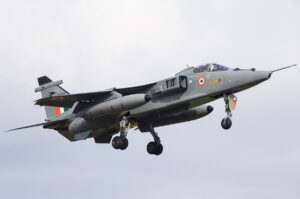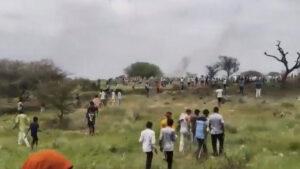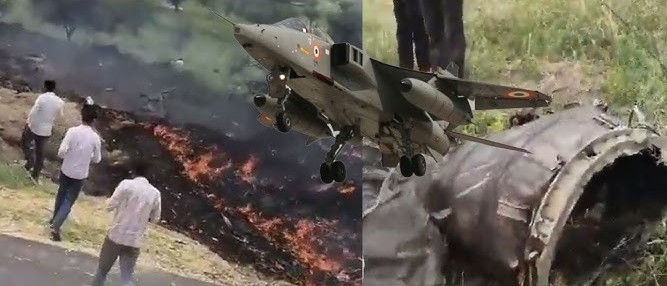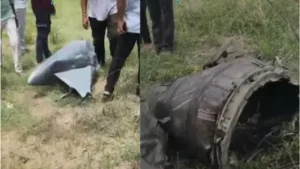💥 What Happened: Tragedy in Churu
On July 9, 2025, at approximately 1:25 PM, an IAF Jaguar fighter jet tragically crashed near Bhanuda village in Churu district, Rajasthan. The twin‑seater Jaguar aircraft, returning from a routine training sortie from Suratgarh Airbase, hit an agricultural field—triggering a horrific burst of flame and debris raining down across farmland. Villagers reported loud blasts, fireballs, and aircraft parts strewn over more than a 200‑foot radius.
🙏 Fallen Heroes: Two Pilots Killed
The jet carried two pilots—a pilot and co‑pilot—who sadly sustained fatal injuries in the crash. No survivors were found at the scene; human remains were recovered among the wreckage. Authorities immediately cordoned off the area as the Indian Air Force (IAF) and local police rushed to assist and launch an investigation.
🚨 Emergency Response & Initial Findings
Rescue teams, including an IAF helicopter, reached the site within minutes of the crash.
The IAF confirmed via a statement: “An IAF Jaguar Trainer aircraft met with an accident … Both pilots sustained fatal injuries … No damage to any civil property.”
A Court of Inquiry has been established to determine the root cause—whether technical malfunction, pilot error, or other contributing factors.
⚠️ Why This Crash Matters: A Pattern of Concern
This is the third Jaguar crash in 2025, spotlighting troubling trends in the IAF Jaguar fleet:
April: A Jaguar crashed near Jamnagar, killing one pilot during a night sortie.
March: Another Jaguar crashed near Ambala (Panchkula, Haryana); the pilot ejected safely.
Now July: A second fatal crash, deepening fears over Jaguar aircraft safety in training and operational roles.
This string of mishaps raises critical questions: Are these Jaguar fighter jets aging beyond safe operation? Do maintenance protocols need urgent overhaul?

🛡️ Jaguar Aircraft: A Legacy at Risk
The SEPECAT Jaguar, in Indian service since the early 1980s, has long been a backbone of the IAF’s ground-attack fleet. The fleet underwent upgrades like DARIN‑III, yet still faces concerns:
Around 139 Jaguars remain operational.
The first batch is scheduled for retirement between 2028 and 2031, while others are being modernized with improved avionics.
However, aging airframes and engine fatigue are straining the aircraft under demanding training conditions.
The Churu crash underscores that even upgraded Jaguars may no longer be reliable in high‑intensity missions.

📌 Scene at Churu: Flames, Crater & Debris
Local accounts describe horror:
“We saw the jet fall in flames… bodies were mutilated… debris scattered over 200 feet.”
A massive crater and burning wreckage marred the farmland. Thankfully, no civilian property was harmed—vital as the pilot appears to have steered the jet away from nearby hamlets, possibly saving many lives in the process.
🧭 What’s Next: Investigation & Urgent Reforms
Court of Inquiry to uncover technical or human reasons behind the crash.
A temporary grounding of the Jaguar fleet is likely, pending inspections.
Safety audits will evaluate whether upgrades like DARIN‑III are sufficient.
Calls may increase to fast-track modern aircraft like the HAL Tejas and AMCA, replacing aging Jaguars altogether.
🤔 Public and Military Reaction
IAF officials and Rajasthan’s leadership expressed deep sorrow and extended condolences to the bereaved families.
Defense experts warn: “The pattern of IAF jet crash incidents involving Jaguars risks eroding pilot morale and public trust.”
A national conversation has begun around the safety of India’s aging military aircraft, pushing for immediate modernization.
✅ Summary: Key Takeaways
The Churu fighter jet crash is the deadliest Jaguar aircraft incident of 2025.
It raises serious concerns about the viability of IAF Jaguar jets.
An urgent safety review and fleet modernization plan is now imperative.
🧠 Final Word: A Wake-Up Call Over Churu
The Churu Jaguar fighter jet crash is not just another tragic loss—it’s a wake-up call. With multiple IAF Jaguar crashes in 2025 alone, India’s aging legacy fleet is clearly at a breaking point.
The IAF must act swiftly: investigate thoroughly, enhance flight safety protocols, and accelerate the induction of modern, indigenous fighter aircraft.
Because this isn’t just about machines—it’s about saving the lives of those who fly them.
for more updates visit: The Morning Draft


